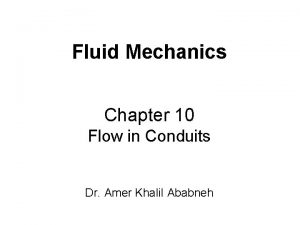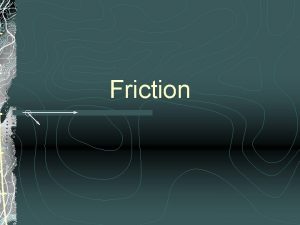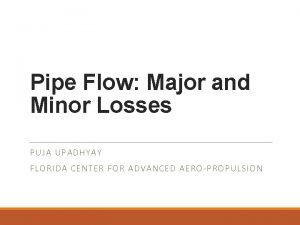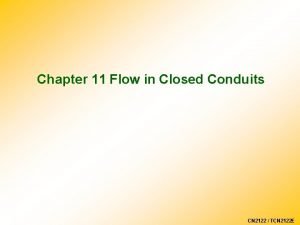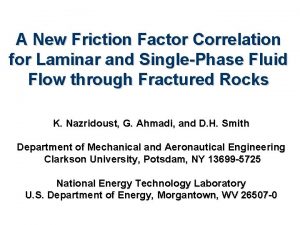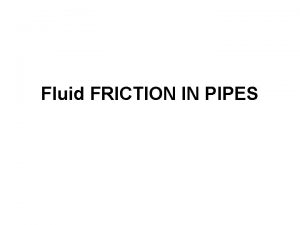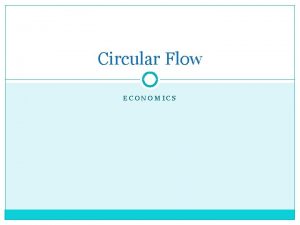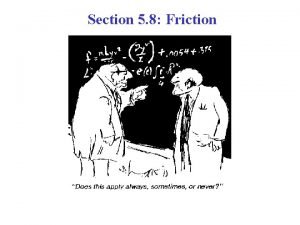Fluid FRICTION IN PIPES Fluid flow in circular















- Slides: 15

Fluid FRICTION IN PIPES

Fluid flow in circular and noncircular pipes is commonly encountered in practice. The hot and cold water that we use in our homes is pumped through pipes. Water in a city is distributed by extensive piping networks. Oil and natural gas are transported hundreds of miles by large pipelines. Blood is carried throughout our bodies by arteries and veins. The cooling water in an engine is transported by hoses to the pipes in the radiator where it is cooled as it flows. Thermal energy in a hydronic space heating system is transferred to the circulating water in the boiler, and then it is transported to the desired locations through pipes. Fluid flow is classified as external and internal, depending on whether the fluid is forced to flow over a surface or in a conduit. Internal and external flows exhibit very different characteristics. In this chapter we consider internal flow where the conduit is completely filled with the fluid, and flow is driven primarily by a pressure difference. This should not be confused with openchannel flow where the conduit is partially filled by the fluid and thus the flow is partially bounded by solid surfaces, as in an irrigation ditch, and flow is driven by gravity alone.

• OBJECTIVES When you finish reading this chapter, you should be able to • Have a deeper understanding of laminar and turbulent flow in pipes and the analysis of fully developed flow • Calculate the major and minor losses associated with pipe flow in piping networks and • Understand the different velocity and flow rate measurement Calculate the sizes of the pips.

• We start this chapter with a general physical description of internal flow and the velocity boundary layer. We continue with a discussion of the dimensionless Reynolds number and its physical significance. • We then discuss the characteristics of flow inside pipes and introduce the pressure drop correlations associated with it for both laminar and turbulent flows. Then we present the minor losses and determine the pressure drop and the sizes requirements for real-world piping systems.

• The terms pipe, duct, and conduit are usually used interchangeably for flow sections. In general, flow sections of circular cross section are referred to as pipes (especially when the fluid is a liquid), and flow sections of noncircular • cross section as ducts (especially when the fluid is a gas). Small diameter pipes are usually referred to as tubes. Given this uncertainty, we will use more descriptive phrases (such as a circular pipe or a rectangular duct) whenever necessary to avoid any misunderstandings.

LAMINAR AND TURBULENT FLOWS If you have been around smokers, you probably noticed that the cigarette smoke rises in a smooth plume for the first few centimeters and then starts fluctuating randomly in all directions as it continues its rise. Other plumes behave similarly (Fig. 8– 3). Likewise, a careful inspection of flow in a pipe reveals that the fluid flow is streamlined at low velocities but turns chaotic as the velocity is increased above a critical value, as shown in Fig. 8– 4. The flow regime in the first case is said to be laminar, characterized by smooth streamlines and highly ordered motion, and turbulent in the second case, where it is characterized by velocity fluctuations and highly disordered motion. The transition from laminar to turbulent flow does not occur suddenly; rather, it occurs over some region in which the flow fluctuates between laminar and turbulent flows before it becomes fully turbulent. Most flows encountered in practice are turbulent. Laminar flow is encountered when highly viscous fluids such as oils flow in small pipes or narrow passages.


Reynolds Number • The transition from laminar to turbulent flow depends on the geometry, surface roughness, flow velocity, surface temperature, and type of fluid, among other things. After exhaustive experiments in the 1880 s, Osborne Reynolds discovered that the flow regime depends mainly on the ratio of inertial forces to viscous forces in the fluid. This ratio is called the Reynolds number and is expressed for internal flow in a circular pipe as




LAMINAR FLOW IN PIPES In fully developed laminar flow, each fluid particle moves at a constant axial velocity along a streamline and the velocity profile u (r) r e m a i n s u n c h a n g e d i n t h e f l o w direction. There is no motion in the radial direction, and thus the velocity component in the direction normal to flow is everywhere zero. .


The maximum velocity occurs at the centerline. by substituting r = 0 at the centerline , Therefore, the average velocity in fully developed laminar pipe flow is one half of the maximum velocity.

Pressure Drop and Head Loss
 Total head equation
Total head equation Jack is going skiing
Jack is going skiing Types of friction force
Types of friction force Damping torque definition
Damping torque definition Fluid friction picture
Fluid friction picture The overall direction of a hair design can be analyzed
The overall direction of a hair design can be analyzed Reynolds number turbulent flow
Reynolds number turbulent flow Friction factor for laminar flow
Friction factor for laminar flow Closed conduit
Closed conduit Friction factor laminar flow
Friction factor laminar flow Imageless-thought debate
Imageless-thought debate Heat pipes for electronics cooling applications
Heat pipes for electronics cooling applications Cpvc pipes in uae
Cpvc pipes in uae Palm pipes
Palm pipes Rtos mailbox
Rtos mailbox Limited access zones around masonry wall
Limited access zones around masonry wall
